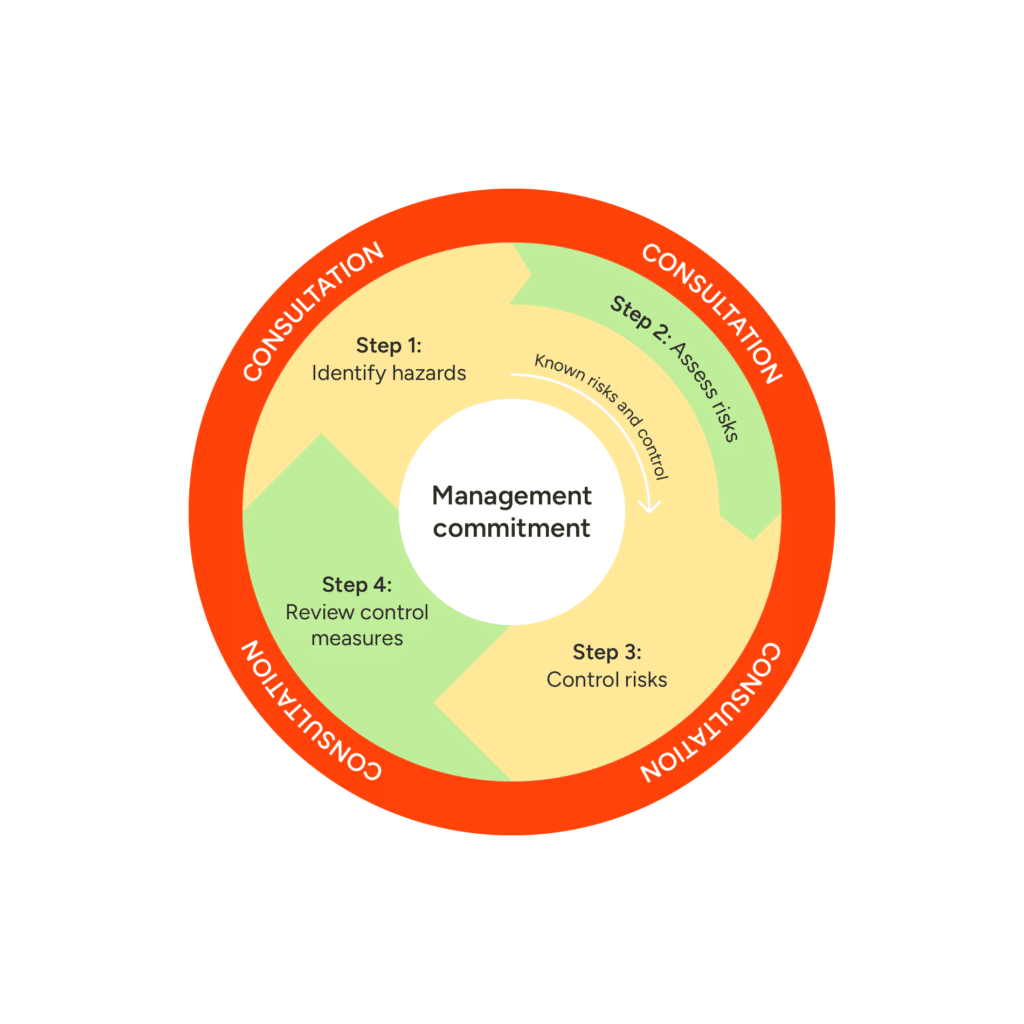
How we can help your business

Don’t face safety issues on your own
We’ve created a unique suite of psychosocial management offerings designed to assist Australian businesses in complying with their WHS obligations regarding psychosocial hazards and enhancing workplace safety and compliance.
Backed by industry-leading WHS experts
These services are designed to enhance your organisation’s safety culture and ensure that your team is equipped to handle WHS challenges effectively. They help you meet your WHS obligations, avoid work-related injuries and illnesses, and reduce the risk of litigation and workers compensation claims.

What are the consequences of non-compliance?
The regulatory enforcement of compliance with obligations related to psychosocial risks is set to increase significantly in the coming years. Under the 2024-26 Psychological Health and Safety Strategy, SafeWork NSW inspector visits are expected to rise by 25 per cent. The focus will be on ensuring that workplaces adopt a proactive approach to psychological health and safety, rather than simply responding to incidents after they happen. This involves managing existing risks in the workplace, not just identifying new ones.
Though this campaign is led by SafeWork NSW, the requirement to manage psychosocial risks applies to all businesses in Australia under health and safety laws, as part of their primary duty of care. Non-compliance with WHS laws can result in regulatory Improvement Notices, penalties, increased premium costs, higher attrition rates, and decreased productivity.
Like physical hazards, psychological risks require prompt management. Businesses must act decisively to create safe and supportive environments for all workers. They need to be proactive, not reactive.
The business and people imperative: proactive over reactive

To create a psychologically healthy and safe workplace, adopt a risk-based approach: identify potential harms, consult with workers, implement control measures, monitor safety, and regularly review work design.
- Identify psychosocial risks: begin by identifying potential psychosocial hazards in the workplace.
- Assess the risks: understand the nature and severity of each identified risk.
- Consult with workers: engage with employees to gain their insights and feedback on the identified risks and proposed control measures.
- Implement control measures: develop and implement measures to control these risks.
- Monitor and review: continuously monitor the effectiveness of these control measures and review them regularly to ensure they remain effective.
Proactively identifying and managing psychological risks helps address issues before they escalate. Engaging with workers ensures measures are practical and effective, allowing businesses to avoid recognising risks only after harm occurs. Tackling these risks can save money, boost employee well-being, and enhance organisational performance and productivity.
Want to find out more? We’ve got answers
Psychosocial hazards refer to elements within the workplace that relate to how work is designed, organised, and managed, as well as the social and environmental context in which the work occurs.
These hazards have the potential to cause psychological or physical harm to employees, impacting their mental health, well-being, and overall job satisfaction. Some common examples include high job demands, low job control, poor support from supervisors or colleagues, bullying and harassment, role clarity, poor change management, inadequate recognition and reward, and poorly managed organisational change.
The difference between physical and psychological health and safety lies in the aspects of well-being they address:
- Physical health and safety: this focuses on protecting individuals from physical harm or injury in the workplace. It includes appropriate control measures to prevent accidents, exposure to physically hazardous environments or substances, and ergonomic issues, as well as ensuring a safe physical environment (e.g., proper equipment, fire safety, and protective gear).
- Psychological health and safety: this emphasises mental and emotional well-being. It involves creating a supportive work environment that minimises stress, prevents workplace bullying or harassment, promotes work-life balance, and addresses factors like job insecurity or excessive workload that can impact mental health.
In short, physical health and safety deal with the body, while psychological health and safety focus on the mind. Both are essential for a holistic approach to health and safety duties, workplace well-being, and the risk assessment process.
In Australia, the Model Work Health and Safety Act and the Model Work Health and Safety Regulations were developed in partnership with Safe Work Australia.
Each state and territory in Australia, other than Victoria, has adopted the Model Work Health and Safety Act. Victoria has maintained its Occupational Health and Safety Act. However, the obligations of businesses under the Victorian legislation regarding psychosocial hazards and risk are principally the same as those under the Model WHS Act.
Each state and territory’s ‘Safe Work’ regulator enforces the WHS/OH&S laws. It’s Safe Work or Work Safe, which conducts inspections and imposes penalties on businesses for non-compliance, including regulatory Improvement Notices.
It doesn’t. The law treats psychosocial hazards exactly the same as physical hazards. In other words, there is no distinction between an employee slipping on a puddle at work and breaking their arm, and developing a stress injury because of overwork.
WHS law requires you to manage both hazards and risks to the same standard.
By using the proactive risk management framework outlined above. That is, identifying hazards, assessing risks, implementing control measures, and regularly reviewing the effectiveness of those measures.
Citation Safety’s psychosocial management services are designed to take the guesswork out of this for our clients, helping ensure each aspect is effectively managed to minimise risk and reduce psychological harm.
A psychosocial management plan is a structured approach that helps businesses identify, assess, and manage psychosocial hazards in the workplace. These hazards can include factors like excessive stress, workplace bullying, or poor work-life balance, all of which can impact employees’ mental health and well-being.
A well-designed management plan outlines strategies to mitigate these risks, ensuring your business complies with health and safety regulations and fosters a positive, supportive work environment.
Clients receive a tailored psychosocial management plan under Citation’s psychosocial management offering.
An Employee Assistance Program (EAP) is a confidential support service offered to employees to help them deal with personal or work-related problems. EAPs typically provide counselling, stress management, mental health support, and other resources to improve employees’ well-being. By offering an EAP, businesses can create a healthier, more resilient workforce, reducing the impact of psychosocial risks such as stress and burnout.
Citation Safety is proud to partner with industry experts, Connect Psych Services, to deliver its EAP to clients.
No, an Employee Assistance Program (EAP) isn’t a legal requirement. However, under the WHS laws, businesses are required to manage psychosocial hazards in the workplace, which may include providing support services like an EAP. While it’s not mandatory, offering an EAP is considered a best practice for promoting mental health and managing workplace risks. It’s a control measure invariably recommended by Safe Work when issuing Improvement Notices to businesses following an inspection.
An Employee Assistance Program (EAP) can benefit your business in several ways. It supports employees by providing access to professional counselling and mental health resources, which can help them manage stress, resolve conflicts, and maintain a healthy work-life balance. By addressing these issues early, an EAP can reduce absenteeism, increase productivity, and improve employee morale. Additionally, it helps businesses manage psychosocial risks and comply with health and safety regulations, creating a safer, more supportive workplace for everyone.
Psychosocial hazards are factors in the workplace or environment that can negatively impact an individual’s mental health, well-being, or social interactions. Here are five examples of harmful behaviours that can lead to psychosocial hazards at work:
- Workplace bullying or harassment: repeated, unreasonable actions directed at an employee, causing work-related stress or harm.
- Job insecurity: fear of losing one’s job or uncertainty about future employment.
- Excessive workload: unrealistic deadlines, long hours, or high-pressure tasks leading to burnout.
- Lack of support: insufficient practical guidance, feedback, or assistance from supervisors or safety representatives to prevent the most common psychosocial hazards.
- Workplace violence: threats, physical harm, or verbal abuse occurring in the workplace that present inherent psychosocial hazards or the potential for post traumatic stress disorder.
Whether they’re the result of poor workplace relationships or traumatic events, work-related psychosocial hazards and psychologically harmful workplace behaviours must be taken seriously, and this includes implementing processes, policies and procedures that work to eliminate psychosocial risks and achieve compliance.
Common psychosocial hazards in the workplace can significantly affect employees’ mental health, well-being, and workplace health. These hazards at work include harmful behaviours such as workplace bullying and harassment, which can lead to psychological harm and work-related stress. Excessive job demands, like unrealistic deadlines and high-pressure tasks, may result in burnout and negatively impact work-life balance. Poor organisational justice often creates stress by fostering feelings of unfairness, while poor support from supervisors or colleagues exacerbates confusion and uncertainty. Role ambiguity, combined with hazardous working environments, can make it difficult for persons conducting their duties to maintain their own health, increasing the risk of both psychological and physical injuries. Traumatic events or ongoing safety risks, such as workplace violence, threats, or isolation, amplify the need for emotional support and controlling risks.
Addressing these health and safety issues requires managing risks through effective control measures. Relevant duty holders, including employers and other relevant figures, must undertake duties with reasonable care to manage psychosocial hazards. For instance, following a code of practice or implementing safety regulations can help mitigate psychological harm. Ensuring proper job demands, emotional support, and fair organisational policies helps to maintain both workplace health and safety. By prioritising a balance between physical hazards and psychological well-being, organisations can safeguard employees against poor-quality work environments and the harmful effects they carry.









